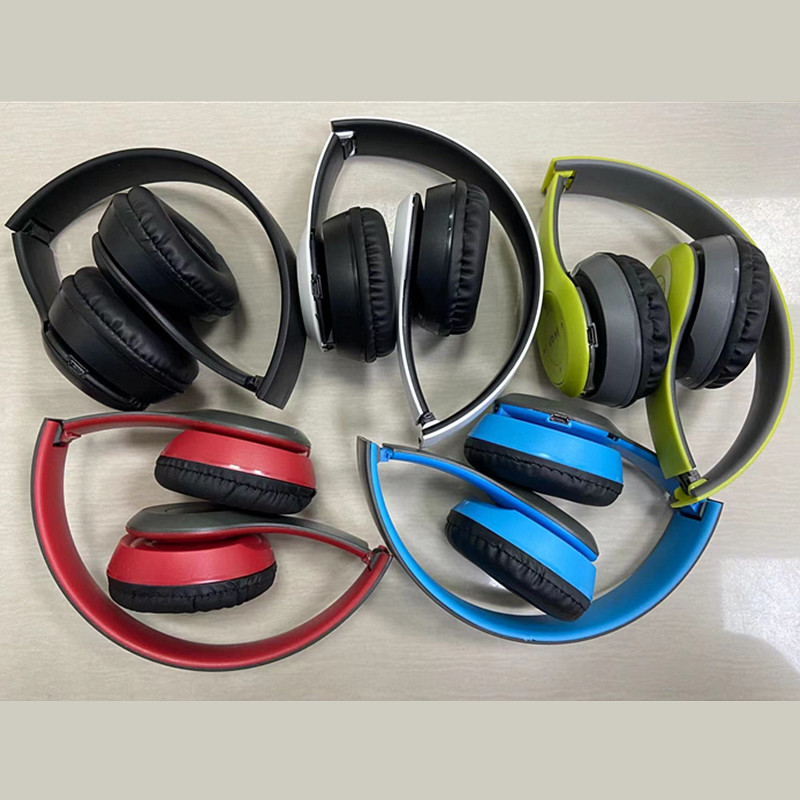Bluesound Pulse M assessment: a wi-fi speaker that fails to justify its substantial price ticket, sonically talking
Bluesound Pulse M: two-minute assessment
The Bluesound Pulse M is a mid-market multi-room speaker that guarantees huge, immersive sound. It is suitable with each lossless streaming and hi-res audio over a wired connection, and is clearly geared toward audiophiles who’re in search of a compact but versatile speaker. On prime of this, its angled tweeters are billed as offering a broader stereo impact than many single-unit setups are able to.
The Bluesound Pulse M’s audio is impressively detailed, as you’d count on from a speaker able to lossless streaming. I used to be impressed by how Diamonds on the Soles of Her Footwear by Paul Simon managed to sound each heat and crisp, together with his voice rising above the combo and that tight, noodly guitarwork slicing proper by means of. And its stereo impact is genuinely spectacular – when you gained’t hear two distinct channels for left and proper per se, there’s nonetheless a separation to its sound that feels broader than a single speaker ought to have the ability to ship.
Sadly, that is considerably undermined by how unbalanced the audio might be. Like quite a lot of audio system lately, the Pulse M bets massive on bass, which might usually be a reasonably protected guess for a fan of sub like myself. Nevertheless, within the course of it neglects different frequencies, with mids specifically struggling in comparison with most of the greatest wi-fi audio system. With its sub and kicks, a slice of heat tech like Burst by Kiasmos ought to actually shine on a bassier speaker, however as an alternative that dusty arpeggiated synth and plush strings got here off as barely foggy right here.
It’s doable to rectify this utilizing a few of the speaker’s sound profiles. Personally, I discovered Entrance Row, Bluesound’s enhanced profile, to be a little bit of a humid squib – it completely has an affect on the sound, giving it a bit extra urgency, however that comes on the expense of a compressed feeling general. As an alternative, I discovered utilizing the BluOS app’s settings to spice up treble and duck the bass achieved higher outcomes – though I did discover myself wishing it had correct EQ settings to present me much more direct management over the sound.
On the subject of establishing and controlling the Pulse M, Bluesound’s BluOS app is simple sufficient to make use of, though it has some odd points right here and there. When establishing the speaker, a number of steps would fail, solely to instantly succeed once I retried. And these glitches prolong to its Alexa voice management talent as effectively. I discovered I used to be capable of pause, play and skip music, however each time I requested my Echo Dot to pick a particular observe the Pulse M remained obstinately silent – so if voice management is your factor, you may be higher off with top-of-the-line good audio system as an alternative.
Design might be the world the place the Pulse M shines most. It’s effectively constructed, feeling sturdy with out being overly heavy or cumbersome, whereas its white matte end feels suitably premium to the contact. A built-in proximity sensor solely lights up the buttons if you wave your hand close to, which feels appropriately sci-fi. Nevertheless, I’d personally choose the touch-sensitive buttons to have some haptic suggestions; providing that rapid suggestions when pressed would make it far more apparent when the speaker has registered your enter.
All in all, the Bluesound Pulse M is a top quality mid-range speaker that is capable of produce detailed, hi-res audio. In the end although, it lacks the nuance I’d count on from a speaker that prices $399 / £399 – highly effective bass shouldn’t come on the expense of lush, expressive mids. Coupled with the truth that equally priced audio system supply extra – the JBL Authentics 200 gives fuller, extra rounded sound for $349.95 / £299, whereas the spatial-audio-equipped Sonos Period 300 prices simply $449 / £449 / AU$749 – this makes the Pulse M tougher to advocate.
Bluesound Pulse M assessment: specs
| Speaker drivers | 2x tweeters, 1x woofers |
| Amplification | 80W complete system energy, twin amp |
| Dimensions | 6.7 x 8 x 5.9 inches (171 x 204 x 149mm) |
| Connectivity | Wi-Fi 5, Bluetooth 5.0, USB, 3.5mm line-in, Ethernet |
| Streaming help | BluOS app, Apple AirPlay 2 |
| Voice assistant help | Alexa |
| Different options | Multi-room management, BluOS residence theater possibility, stereo pair possibility |
Bluesound Pulse M assessment: value and availability
- Launched October 26, 2022
- Prices $399 / £399 / AU$899
Launched on October 26, 2022, the Bluesound Pulse M is available for purchase now. It retails for $399 / £399 / round AU$899, which places it firmly in mid-market territory – it prices a good means north of the Sonos Period 100 at $249 / £249 / AU$399 however doesn’t fairly price as a lot as its premium cousin the Sonos Period 300 at $449 / £449 / AU$749.
In return on your spend, you’ll get a compact speaker with 80W of mixed amplification, a single woofer and two angled tweeters. There’s not an enormous selection by way of choices. It is available in simply two colorways – black or white – however that’s fairly frequent with extra premium audio system.
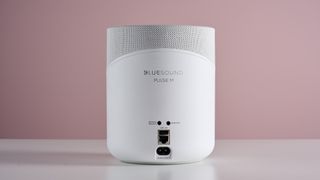
Bluesound Pulse M assessment: options
- Nice vary of connectivity choices
- Occasional app gremlins
- Restricted EQ choices
The Bluesound Pulse M rocks a good variety of options for a wi-fi, multi-room speaker, with out essentially ripping up the rulebook. It gives a mixed 80W complete amplification energy, with 50W going to its upfiring 5.25-inch woofer and 15W to every of its 0.75-inch tweeters. The latter two are offset at 45 levels from one another to present what Bluesound describes as an ‘immersive’ soundstage. Mixed with an inbuilt acoustic reflector, this helps to radiate higher-frequency sounds in a 360-degree sample, lowering the impression that the sound all emerges from a single level in area.
Getting began with the Pulse M is comparatively easy. When you’ve downloaded the BluOS app you simply want to attach your cell machine to the speaker’s hotspot so it may piggyback on it to affix your native Wi-Fi community. This course of is fairly easy, however that doesn’t imply it’s utterly easy crusing – at a number of factors I’d discover the connection course of would day out, solely to attach immediately once I retried. This did add a little bit of friction to the method, notably provided that the Pulse M appeared to want establishing afresh each time it was unplugged.
As soon as the BluOS app is linked, it permits you to connect with the speaker through Bluetooth or AirPlay 2, in addition to connecting particular apps like Spotify, Tidal and Amazon Music on to the Pulse M. The app additionally lets you pair it with different Bluesound audio system to type a multi-room setup, or pair two Pulse Ms with the Pulse Soundbar+ or PowerNode to create an efficient encompass sound setup on your residence cinema.
The BluOS app can be the place you’ll discover choices to tweak the Pulse M’s sound profiles. On prime of its default profile, it additionally gives Entrance Row, a setting that, based on Bluesound, enhances “richness within the decrease frequencies (5kHz)”. It additionally gives entry to the Tone Management settings, though these are sadly fairly restricted: loads of price range value Bluetooth audio system just like the Tribit Xsound Plus 2 supply full nine-band EQ, whereas this speaker solely lets you increase or cut back treble or bass by 6dB both means. The BluOS app additionally gives ‘Replay-gain’, primarily an auto-gain adjustment that tweaks totally different tracks or albums to ensure they play again at comparable volumes. I can’t say it is a downside I’ve fairly often lately, provided that many streaming providers standardize recordings to be on the identical quantity, however it’s good to have I suppose.
Naturally, the BluOS app isn’t the one technique to management the Pulse M. If you wish to management it as a part of your good residence community, you’ll be able to join it to an Amazon Echo speaker utilizing the BluOS Voice Management talent within the Alexa app. Sadly although, the talent appears to have a number of holes right here and there. Strive as I would, I couldn’t get Alexa to pick particular songs and artists – it might fortunately chirp that music was taking part in by means of my named speaker after which nothing would begin. Once I manually chosen music although, Alexa was at the very least capable of pause and play, in addition to modify the quantity and skip backwards and forwards. So it’s a blended bag: you’ll nonetheless have to succeed in on your cellphone a good quantity.
Do you have to choose utilizing your individual digits to digital controls, the Bluesound Pulse M has a variety of touch-sensitive controls on prime of the speaker itself. These are invisible more often than not, however wave a hand over them and so they’ll mild up – you’ll be able to then faucet them to play and pause, skip forwards and backwards, set the quantity, and decide one in every of 5 audio presets you’ve assigned within the app.
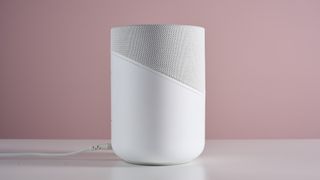
Bluesound Pulse M assessment: sound high quality
- Over-liberal with its bass
- Entrance Row audio profile lacks finesse
- Genuinely spectacular breadth to its soundstage
If you really fireplace up the Bluesound Pulse M, the very first thing you’ll probably discover is its bass. Actually, that’s in all probability the one factor you’ll discover. When listening to Black Eye by Allie X, I used to be instantly impressed with how punchy the kick sounded and the way heat the low subby finish of the bass sounded – however the mids sounded set fairly far again compared. I attempted switching issues as much as Rosewood by Bonobo, a observe that very a lot shines on a hotter speaker and, as soon as once more, it felt just like the bass overshadowed the remainder of the combo, which is fairly disappointing.
Evaluating it to the Sonos Period 100, it grew to become a lot simpler for me to diagnose the issue. In our unique Sonos Period 100 assessment, we criticised it for its over-emphasis on bass and but it comes throughout as much better built-in and extra coherent. In distinction, the Pulse M pulls means too many punches relating to its mids. Weighing up the 2 whereas listening to Younger Blood by The Bare & Well-known, there’s an actual slam and thud to the bass kicks and snares to the Pulse M however, just like the weightlifter who overlooks their core to deal with their legs and arms, all this flexing solely serves to attract extra consideration to its soggy center compared to its trimmer rival.
That’s to not say it utterly lacks all precision. In sparser mixes, issues really feel like they’ve far more room for expression. Listening to the sparser ballad-y composition of Rains once more by Solji, I used to be impressed with how polished and detailed her voice sounds, whereas the drum beats and piano are granted loads of room to breathe – when the bass isn’t hogging all of the limelight, different components are given their likelihood to shine.
Given the default sound is a little bit of a blended bag, you would possibly count on Entrance Row, BluOS’s inbuilt frequency tweaking, to step in and save the day. In follow, it’s a little bit of a blunt device, akin to utilizing a pocket knife for micro-surgery. Some tracks undoubtedly shine extra with it on – initially White Gown by Lana Del Rey sounded a bit demure and lacklustre to me however Entrance Row boosted the breathy edge to her voice and made that mild cymbal work a bit extra crisp. Conversely, it introduced the beat and vocals in Child It’s You by London Grammar ahead loads however on the expense of creating issues sound a bit too compressed.
In my private expertise, you’ll get higher outcomes getting your fingers soiled and tweaking the Tone Management settings based on your individual tastes. Upping the treble by 6dB on London Grammar’s observe gave its hats and Hannah Reid’s honeyed vocal that little extra immediacy, whereas dropping the bass only a fraction by 6dB tamed the Pulse M’s worst impulses. In the end, this setting felt far more balanced for me and I ended up utilizing it as customary just about from there on out.
One place I’ll commend the Pulse M nonetheless is for its soundstage. Because of these angled, stereo tweeters, this speaker gives a a lot wider sound than the slim level of origin that many single audio system are able to. Taking part in Manchild by Eels, there was genuinely a formidable sense of separation between the vocal and the guitar within the left and proper channels, particularly the additional again I used to be sat within the room. Whereas I’m not satisfied I’d describe this as true stereo, as Bluesound has, there’s little question it feels immersive and broad – though it’s not fairly as spectacular because the Dolby Atmos a speaker just like the Sonos Period 300 gives.
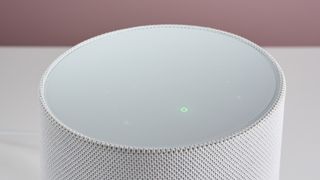
Bluesound Pulse M assessment: design
- Attractive, refined design
- Solidly constructed however not cumbersome
- Controls might supply extra suggestions
For probably the most half, I’m a giant fan of the Bluesound Pulse M’s design. The model has nailed the nexus of minimal and premium that’s completely applicable with a speaker at this value level.
Primarily a cylindrical oval form, it provides off slight Sonos Transfer 2 vibes, whereas nonetheless being distinct sufficient to really feel like its personal beast. It is available in each black or white colorways; for me the latter has the particular edge right here, feeling a lot cleaner and extra futuristic. Its plastic physique has a delightful matte end, whereas the fabric-covered grille has a curved backside edge giving the entire thing a pleasant aesthetic stability. On the subject of the pure look of the machine, I – unusually – don’t have anything destructive to say.
Once more, in construct high quality, the Pulse M occupies a Goldilocks zone of each strong with out being overly cumbersome. The absence of a battery helps right here, in fact: transferring it from room to room requires significantly much less exertion than one thing just like the Transfer 2. Whereas it’s shut in dimension to the Sonos Period 300, it is considerably lighter, weighing in at 2.54kg in comparison with the Period 300’s 4.47kg. Whilst you’re not prone to be repositioning it fairly often, it’ll undoubtedly be much less cumbersome if you do.
One slight niggle facilities across the touch-sensitive controls on prime of the machine. Given they aren’t bodily buttons, I’d personally have most well-liked it in the event that they’d included some haptic, or at the very least aural, suggestions to substantiate a profitable finger press – I wasn’t all the time clear when it had really registered a finger-press on the quantity bar, which means I’d usually stab at it a number of instances to make sure. However extra of a difficulty for me is the dearth of labelling: minimal buttons certain look cool till you’re making an attempt to work out what half of them do, at which level you begin to recognize why virtually all audio system comply with sure conventions, like pluses and minus for quantity or numbers for presets.
All issues thought-about although, this feels extra like splitting gossamer than splitting hairs – the general model and construct of the Bluesound Pulse M is aesthetically pleasing, and creates a good affect in any room it’s located in.
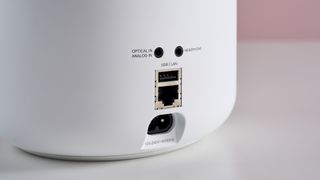
Bluesound Pulse M assessment: worth
- Seems and construct match its premium value
- Sound can’t compete with equally priced audio system
- You’ll probably get higher worth on your spend elsewhere
Weighing up how the Bluesound Pulse M compares by way of worth is a tricky endeavor. On the one hand, it appears beautiful, works as a part of a multi-room setup and may stream true lossless audio. On the opposite, its bass out-of-the-box is severely overblown, its app might be periodically irritating and it’s a bit missing relating to audio optimisation options.
These sorts of compromises would largely be wonderful if the Pulse M was cheaper or the competitors wasn’t so good at this value vary. However this isn’t an inexpensive wi-fi speaker: at an MSRP of $399 / £399 / round AUS899, it’s affordable so that you can count on greater than you’re getting right here. For that form of cash, I desire a speaker to sound nice proper out of the field, ideally with algorithms that optimise the sound relying on the environment. And the Pulse M simply can’t clear that bar, which looks like a missed alternative.
So whereas it is a very succesful speaker in quite a lot of methods, it’s nonetheless not sufficient to fairly justify the excessive price ticket: there are just too many audio system on the market that will provide you with higher sound on your spend. For instance, the JBL Authentics 200 is accessible for $349.95 / £299 / AU$299 and gives each the complete bass and crisp treble of the Bluesound, whereas offering full, convincing mids. Alternatively, the Sonos Period 300 doesn’t retail for far more, at $449 / £449 / AU$749, and it rocks each full sound in addition to that superior spatial audio impact.

Ought to I purchase the Bluesound Pulse M?
| Attributes | Notes | Score |
| Options | Providing some first rate drivers, lossless audio and a superb vary of connectivity choices, the Pulse M has a good function set. Nevertheless, its EQ choices could possibly be extra versatile and bugs within the app and Alexa voice talent barely let it down. | 3.5/5 |
| Sound high quality | The Pulse M doesn’t sound dangerous: it’s a bit too bassy for its personal good and lacks some oomph within the mid-range however it’s tweakable and gives lossless audio, in addition to having an admirable width to its soundstage. Nevertheless, I’d count on extra nuanced sound for this value. | 3.5/5 |
| Design | On the subject of sheer model, the Pulse M nails it. Its elliptical design, smooth matt end and strong construct high quality all assist it stand out in a crowded market. | 4.5/5 |
| Worth | At a value of $399 / £399, the Pulse M must be unimpeachable to maintain up with equally priced rivals. Sadly, the imbalanced sound and few function gaps means it may’t fairly match the tempo of different mid-market wi-fi audio system. | 3/5 |
Purchase it if…
Don’t purchase it if…
Bluesound Pulse M assessment: additionally take into account
| Header Cell – Column 0 | Bluesound Pulse M | Sonos Period 300 | JBL Authentics 200 |
|---|---|---|---|
| Speaker drivers | 2x tweeters, 1x woofers | 4x tweeters, 2x woofers | 2 x 25mm tweeters, 5-inch full-range woofer, 6-inch passive radiator |
| Amplification | 80W complete system energy, twin amp | 6x Class D amps | 90W |
| Dimensions | 6.7 x 8 x 5.9 inches (171 x 204 x 149mm) | 6.30 x 10.24 x 7.28 inch (160 x 260 x 185mm) | 266.3 x 171.7 x 167.4mm |
| Connectivity | Wi-Fi 5, Bluetooth 5.0, USB, 3.5mm line-in, Ethernet | Wi-Fi 6, Bluetooth 5.0, USB-C (3.5mm line-in and Ethernet through adapter) | Wi-Fi, Bluetooth 5.3, USB-C, Ethernet, aux-in |
| Streaming help | BluOS app, Apple AirPlay 2 | Sonos app, Apple AirPlay 2 | JBL One app, Apple AirPlay, Alexa Multi-Room Music (MRM), Chromecast |
| Voice assistant help | Alexa | Alexa, Sonos Voice Management | Google Assistant, Amazon Alexa |
| Different options | Multi-room management, BluOS residence theater possibility, stereo pair possibility | Dolby Atmos help, Sonos multi-room management, Sonos residence theater possibility, stereo pair possibility | Multi-room management |
Bluesound Pulse M assessment: how I examined
- Examined for 2 weeks
- Utilized in a variety of rooms and settings
- Performed a variety of music over Wi-Fi, Bluetooth and wired connections
I spent many hours testing the Bluesound Pulse M over the course of a number of weeks. Not solely did I attempt it out in a number of totally different sized areas, I additionally in contrast it to the Sonos Period 100 and hooked it as much as quite a lot of gadgets, together with my iPhone 16 Professional over AirPlay 2 and the Fiio M11S hi-res music participant through analog stereo 3.5mm enter.
By way of music, I used our curated TechRadar testing playlist, in addition to a big selection of tracks from my private library. This allowed me to check out how the speaker dealt with all the pieces from deep pulsing bass to delicate vocals. I additionally used quite a lot of totally different high quality sources, whether or not that was Spotify’s customary tier, Apple’s lossless tier or Tidal’s hi-res tier.
I’ve been testing audio package like headphones and audio system for a few years now. I’ve additionally spent many years making music in my free time, which has given me quite a lot of perception into analyzing the frequencies of music, composition and soundstage.
- First reviewed: December 2024
- Learn extra about how we check
